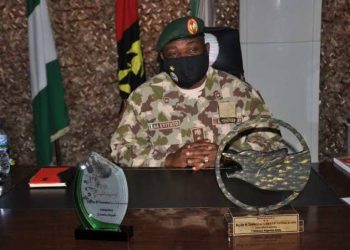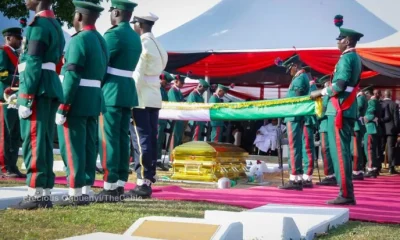Latest News
Boko Haram: 720 surrendered fighters now in Borno custody

No fewer than 720 deadly Boko Haram fighters have surrendered to the Borno State Government from the swathe of forests in Sambisa and Cameroon in the last two months,
About 92 of the fighters were among the 840 who surrendered in Cameroon and returned to Nigeria.
Thorough screening carried out on other returnees revealed that they were farmers.
The returnee fighters have been handed over to the military for disarming and profiling preparatory to their being taken to a camp.
Two of the 720 fighters were said to be experts in bomb making and fabrication of bullets for Boko Haram.
It was learnt that most of the fighters were lieutenants of deceased Boko Haram leader, Abubakar Shekau, who blew himself up in a face-saving move during an ambush against him by rival Islamic State West African Province (ISWAP) fighters.
The Acting General Officer Commanding (GOC), 7 Division, Abdulwahab Eyitayo, said that more than 8,000 Boko Haram fighters, including their wives and children, have so far surrendered to troops.
There were strong indications yesterday that the military might be preparing for the last phase of the battle against the deadly Boko Haram sect.
An informed source, who spoke in confidence, said the death of Shekau encouraged the Borno State Government to adopt a non-kinetic approach in the fight against insurgency.
Non-kinetic approach, according to the source, refers to using more of persuasion than confrontation in getting the insurgents to drop their arms.
The source said: “The surrender of Boko Haram fighters is real. Following the death of Shekau, we adopted non-kinetic approach by opening up communication with them, and it is working.
“These fighters did not want to surrender to the military for fear of the unknown, so it was part of the agreement that the state would handle it.
“Most of the fighters became war-weary after discovering that their leader, Shekau, committed suicide.
“With ideological superior argument on the consequences of suicide for a Muslim, they bought into non-kinetic approach.
“So far, about 720 Boko Haram commanders (fighters) are in custody in three centres established by the Borno State Government. But they were first received by the military at a base in Bama for profiling and disarming before they were taken to the centres.
“The first commander to surrender was Modu M. from Dikwa. He volunteered to come out and through him more than 719 top commanders have surrendered their arms. Among them, we have two experts in bomb making and fabrication of bullets.
“One of the deadly commanders was Rugurugu from Gwoza, who personally came with his wife and children to beg for forgiveness.
”About 92 of the 720 fighters came from the Cameroon axis.
“You should know that actually, 840 suspected Boko Haram members returned from Cameroon. But after profiling, we discovered that 92 of them were commanders while the rest were farmers, abductees and the enslaved ones they were using for support.”
Asked about the fate of the Chibok girls that were yet to return home since they were abducted in 2014, the top source said: “Among those that have surrendered in the last two months, there are three Chibok girls.
“The last Chibok girl we are expecting refused to get married. But she was serving as a slave to Boko Haram.”
On the likelihood of a repeat of the Afghanistan scenario playing out in Nigeria, the top source, who was privy to the ongoing coordination, added: “We are countering their ideological focus. The Borno model will be different from Afghanistan.
“Most of Shekau’s fighters are young boys between 20 and 25 years old. We are hopeful of succeeding in changing their focus.
“In fact, their communities are involved in their identification. We have brought in religious leaders to preach to them as part of their reorientation. We want them to be part of the restoration of the lost glory of Borno State.
“The Governor of Borno State, Babagana Zulum, has unfolded plans for a DRR policy which covers Deradicalization, Demobilization, Reformation, Rehabilitation and Reintegration. We will put them through all these stages in line with international best practices.
“After mopping up the fighters, the actors that will be involved have been doing it before. They are people who are experienced; they will replicate what they have done before.
“As part of the last stage of reconciliation, we may put in place a Truth Commission in order to heal all wounds and avert going through this path again in our history.
“The governor is also considering a Victims Support Programme to assuage all and move the state forward.”
Claims of surrendering Boko Haram fighters genuine — GOC
The Acting General Officer Commanding 7 Division of the Nigerian Army, Brig-Gen. Abdulwahab Eyitayo, said there was no doubt that claims of surrender by some Boko Haram fighters were genuine.
Eyitayo, who spoke in Maiduguri, said more than 8,000 Boko Haram terrorists have so far surrendered to troops.
He said the terrorists surrendered from their enclaves in Sambisa Forest as well as other hideouts.
He however said the adamant ones among the Boko Haram fighters will soon be flushed out.
He said: “The genuineness of their intention to surrender is not in doubt considering that they turned in their families as well. There was no way they could have come out with their families if the intention was suspect.
”One of the reasons they are surrendering in droves is the overwhelming fire power from the troops.
“It is because every man’s endeavour is motivated by his family’s wellbeing. That is why they are coming out with their families. We started seeing the signs in June.
“Our intensified operations had blocked their logistics’ routes and supplies and there were bombardments all over. That was why they started surrendering, and diseases have overpowered many of them.
“It was better because in the end, the troops will clear all of them and their sympathisers combined.
“We are not doing what we are doing in order to pamper the surrendered fighters. Far from it. We are known for our ruggedness and doggedness. 7 Division is the fighting division of the Nigerian Army, and we are not relenting.”
‘Troops on last phase of battle with insurgents’
In spite of the ambush against troops at Marte on Friday, a defence source said the military might be heading for the last phase of the battle against Boko Haram.
The source, who gave an insight into the state of the confrontation, said what was left was the battle with members of the Islamic State West African Province (ISWAP) whose leader, Abu Musab Al-Barnawi, has been killed.
The source said: “All those pockets of ambush and attacks were from ISWAP with a strong base in Gudumbali in Guzamala Local Government Area (LGA) out of the 27 LGAs in Borno State and few parts of Yobe State.
“The same ISWAP attempted to hijack Shekau’s fighters but they refused because ISWAP killed their leader. It was in the process of resistance and attempts to force their way out of Sambisa Forest and other camps that Al-Barnawi was killed by Shekau’s fighters.
“The military is sustaining the fight against ISWAP which is suspected to be in control of Shekau’s faction’s armoury in the Sambisa Forest. We know some ISWAP/ ISIS leaders and members are foreigners. The military will rout them out.
“This 12-year old war will soon end. It is a matter of time. Despite the fact that the military has not yet deployed Tucano jets, the battle is 80 per cent won.
“By the time the military comes out more forcefully in the next few months, the North-East will be liberated from Boko Haram.
“The Federal Government is aware of the development in Afghanistan and likely support for ISWAP/ISIS from this end. But the political and geographical frames of the battle are different.”
– The Nation
Latest News
Ondo, Edo, Bauchi account for 70% of lassa fever cases – NCDC

The latest report of lassa fever from the Nigeria Centre for Disease Control (NCDC) showed that as of July 24, 2022, Indo, Edo and Bauchi states contributed 70 percent of the total cases of Lassa fever in the country.
Ondo, Edo and Bauchi recorded of 30 per cent, 26 per cent, and 14 per cent respectively.
It also revealed that between July 18 and 24, new confirmed cases increased to 10 from five the previous week.
Two persons lost their lives during the period under consideration. Therefore, since the beginning of the year, the total confirmed cases of Lassa fever are 857, with 164 total deaths reported.
The NCDC said, “Cumulatively from week 1 to week 29, 2022, 164 deaths have been reported with a Case Fatality Rate (CFR) of 19.1 percent, which is lower than the CFR for the same period in 2021 (23.7 percent).
“In total for 2022, 24 states have recorded at least one confirmed case across 99 Local Government Areas.
“Of all confirmed cases, 70 percent are from Ondo (30 percent), Edo (26 percent), and Bauchi (14 percent) states. The predominant age group affected is 21-30 years (Range: 0 to 90 years, median age: 30 years). The male-to-female ratio for confirmed cases is 1:0.8.
“The number of suspected cases has increased compared to that reported for the same period in 2021. One new Healthcare worker affected in Ondo State.
“National Lassa fever multi-partner, multi-sectoral Technical Working Group (TWG) continues to coordinate the response activities at all levels.”
To reduce the risk of the spread of Lassa fever, the NCDC offers the following advice: Ensure proper environmental sanitation – that is, keep your environment clean at all times, block all holes in your house to prevent rats from entering; Cover your dustbins and dispose of refuse properly. Communities should set up dumpsites very far from their homes to reduce the chances of having rodents within homes; Store foodstuff like rice, garri, beans, corn/maize, etc in containers that are well covered with tight-fitting lids.
Others are – Avoid drying foodstuffs outside on the floor, roadside where they will be exposed to contamination; Avoid bush burning which can lead to the displacement of rats from bushes to human dwellings; Eliminate rats in homes and communities by setting rat traps and other means; Practice good personal hygiene by frequent washing hands with soap under running water or use of hand sanitisers when appropriate, and visit the nearest health facility if you notice any of the signs and symptoms of Lassa fever as mentioned earlier, and avoid self-medication.
Latest News
Insecurity: FG urged to seek foreign help

The Federal Government of Nigeria has been advised to seek foreign help urgently in order to tackle the problems of insecurity in the country.
According to a statement by a renowned socio-political activist and critic, Chief Adesunbo Onitiri, this became very imperative to enable Nigerians to live in peace.
He also called on the government to declare a state of emergency on insecurity in order to tackle the problem with all the seriousness it deserved.
Onitiri said the only option left was to urgently seek foreign assistance.
“We wake up daily to hear news of our youths, women, and citizens being raped, kidnapped, maimed, and killed.
“While the country is in a state of war with the bandits, our students are out of school for over five months. All our higher institutions are under lock and key. This is unacceptable to Nigerians,” Onitiri lamented.
Onitiri explained that the Kuje Prison and the Kaduna military formations attacks were sour in the mouth. “It’s like our sovereignty as a nation has been eroded.”
Latest News
164 Die Of Lassa Fever As Cases Jump To 857

THE Lassa fever cases in Nigeria have jumped to 857 and 164 people have so far died from the disease in the first seven months of 2022.
The Nigeria Centre for Disease Control (NCDC) said this in its latest Lassa fever situation report for week 29, which showed that there were 857 confirmed cases of the disease in the country.
The NCDC said that the cases were distributed across 24 states and 99 local government areas in the country.
It said that 54 healthcare workers had been infected with the disease.
“A breakdown indicated that of all confirmed cases, Ondo has 30 per cent Edo, 26 per cent and Bauchi 14 per cent states.
“In week 29, the number of new confirmed cases increased from five in week 28, 2022 to cases. These were reported from Edo and Ondo States.
“Cumulatively from week 1 to week 29, 2022, 164 deaths have been reported with a case fatality rate (CFR) of 19.1 per cent which is lower than the CFR for the same period in 2021, 23.7 per cent.
“In total for 2022, 24 States have recorded at least one confirmed case across 99 Local Government Areas. Of all confirmed cases, 70 per cent are from Ondo, 30 per cent Edo 26 per cent and Bauchi 14 per cent cases.
“The predominant age group affected is 21-30 years range: 0 to 90 years, Median Age:30 years. The male-to-female ratio for confirmed cases is 1:0.8.
“The number of suspected cases has increased compared to that reported for the same period in 2021. One new healthcare worker was affected in Ondo State,” it said.
The News Agency of Nigeria (NAN) reported that Lassa fever is a viral hemorrhagic fever transmitted by rats.
It has been known since the 1950s, but the virus was not identified until 1969 when two missionary nurses died from it in the town of Lassa in Nigeria.
Even after recovery, the virus remains in body fluids, including semen. Neighbouring countries are also at risk, as the animal vector for the Lassa virus, the “multimammate rat” (Mastomys natalensis) is distributed throughout the region.
-

 Sports2 days ago
Sports2 days agoBREAKING: Super Eagles qualify for AFCON 2025
-

 Aviation3 days ago
Aviation3 days agoDisaster averted as bird strike hits Abuja-Lagos Air Peace flight
-

 metro2 days ago
metro2 days agoCourt orders varsity to pay lecturer N40m compensation for wrongful dismissal
-

 metro14 hours ago
metro14 hours agoSouth-West NURTW: Why we chose Oluomo over Baruwa
-

 Opinion2 days ago
Opinion2 days agoApomu king turns warmonger for PDP
-

 Politics2 days ago
Politics2 days agoOndo poll: Three gov candidates withdraw for Aiyedatiwa
-

 News3 days ago
News3 days agoEdo Gov Okpebholo freezes govt accounts, reverses ministry’s name
-

 News1 day ago
News1 day agoLate COAS Lagbaja gets CFR honour, buried amid tributes


